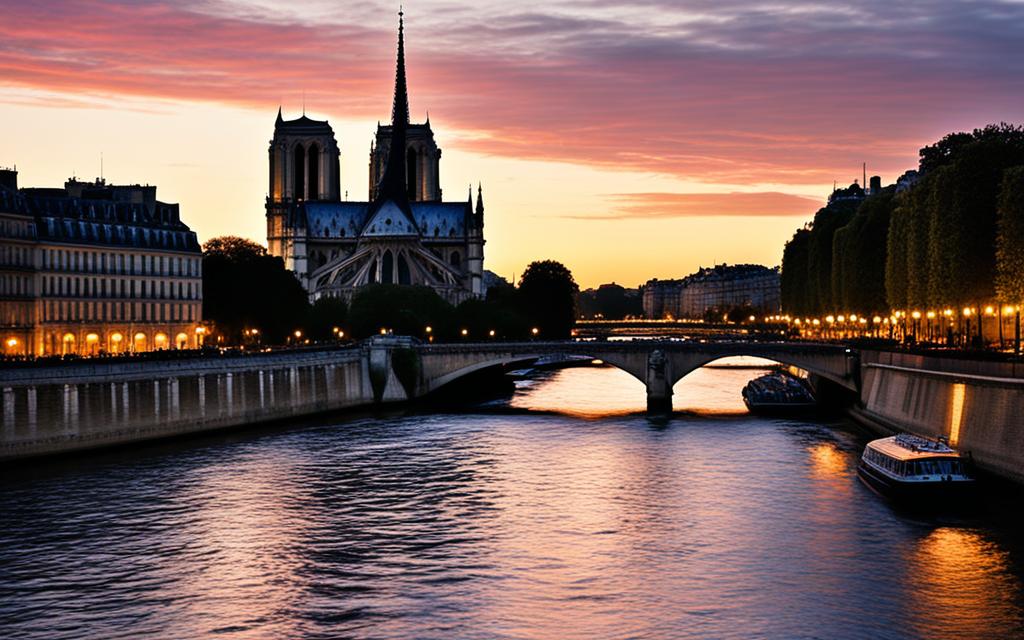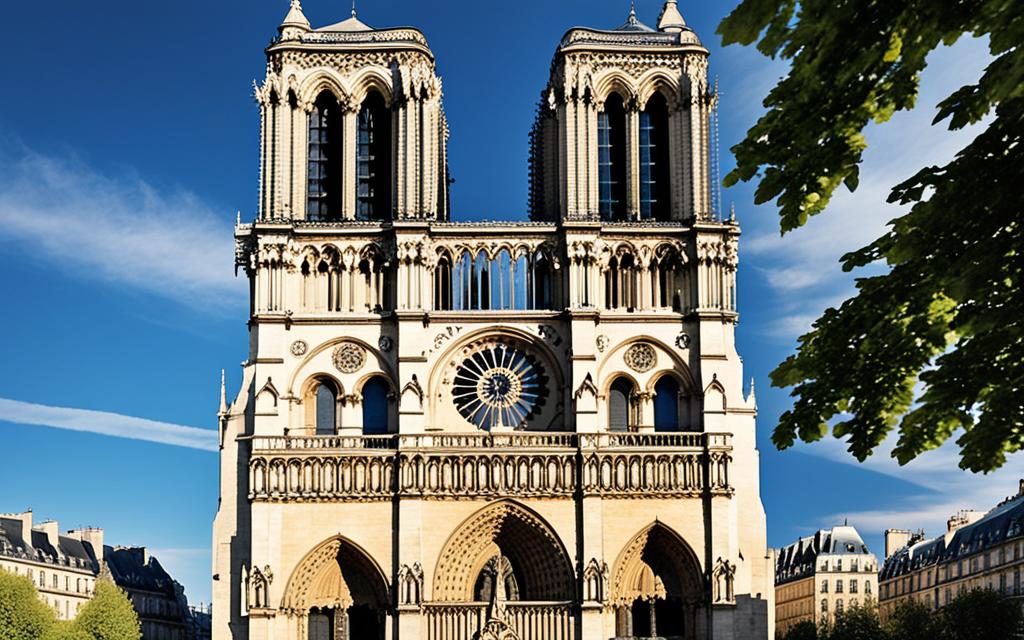Imagine the sunlight shining through colorful stained glass windows at Notre Dame Cathedral. It creates a magical scene. This iconic Parisian site has drawn visitors for centuries with its grandeur. It stands as a symbol of human creativity and resilience.
The Notre Dame Cathedral is a UNESCO World Heritage site. It’s famous for its detailed stone carvings, tall spires, and the historic rose windows. Dating back to the 12th century, its construction took over two centuries. Many craftsmen and builders worked on this beautiful building.
Key Takeaways
- The Notre Dame Cathedral is a renowned French Gothic landmark located in the heart of Paris.
- It is renowned for its striking architecture, including the famous rose windows, flying buttresses, and intricate stone carvings.
- The cathedral has stood as a symbol of French culture and history for centuries, inspiring countless works of art and literature.
- In 2019, the cathedral suffered a devastating fire, but ongoing restoration efforts are underway to preserve this cherished Parisian monument.
- The Notre Dame Cathedral is a UNESCO World Heritage site, recognized for its outstanding universal value and cultural significance.
The Notre Dame Cathedral: A Marvel of Gothic Architecture
The Notre Dame Cathedral in Paris shows off the stunning Gothic architecture of Medieval Europe. Building work began in the 12th century and finished over 200 years later. Many French architects and builders worked on it, adding to its beauty over time.
History and Origins
In the 1160s, Maurice de Sully, the Bishop of Paris, started making plans. His goal was to replace an old Romanesque church with a new Gothic cathedral. This choice showed the latest architectural styles of the time.
Architectural Grandeur
The cathedral is a stunning example of the Gothic style. It features tall pointed arches, detailed stone carvings, and flying buttresses. The front is especially impressive, with hundreds of statues and gargoyles, all showcasing expert French skill.
Iconic Stained Glass Rose Windows
The stained glass rose windows are world-famous and a must-see at Notre Dame. These large, circular windows are over 40 feet across. They are not just beautiful but also a marvel of medieval engineering.
Notre Dame’s Place in French History and Culture
The Notre Dame Cathedral is a key part of French history and culture. It’s been a place of worship and a witness to the country’s past. It has seen coronations and revolutions over the years.
It stands as a Parisian landmark and represents Medieval Europe. The cathedral shapes France’s culture deeply. People are drawn to its Gothic beauty and detailed art, like writers and musicians.
Besides its look and art, Notre Dame has meaning for Catholic church activities. It has hosted big religious and political events. The cathedral echoes French history and values through these moments.

Today, Notre Dame remains a top symbol of French history and culture. It welcomes millions of visitors each year. They come to see its beauty and feel connected to France’s past.
A Symbol of Medieval Europe
The Notre Dame Cathedral is a key part of French history and culture. It is a symbol of artistic and religious traditions in Medieval Europe. This Gothic masterpiece has shaped European art and literature.
Influence on Art and Literature
The cathedral’s tall spires, detailed carvings, and beautiful stained glass rose windows found recognition among artists and writers across time. From paintings to manuscripts, the Notre Dame Cathedral is a common subject. It represents art and creativity in Medieval Europe.
Victor Hugo’s “The Hunchback of Notre Dame” stands out as a key piece from 1831. It brings to life the cathedral’s details and its symbolic place in the story. This fiction made the Notre Dame Cathedral a prominent symbol of the Catholic church and Medieval Europe.
Significance in Religious History
Apart from its cultural impact, the Notre Dame Cathedral is central to the religious history of Medieval Europe. It has hosted key religious events, like royal ceremonies and pope visits. These events highlighted its role in the Catholic church.
The grand spires and detailed architecture symbolize the Catholic church’s strength in Medieval Europe. The Notre Dame Cathedral speaks of the deep faith and cultural significance of Medieval Europe. It remains a historic token of that era.
Notre Dame: A UNESCO World Heritage Site
Notre Dame Cathedral is a UNESCO World Heritage site. It’s recognized for its importance worldwide. It meets UNESCO’s tough standards for being a unique and valuable place.
Criteria for World Heritage Designation
The Notre Dame Cathedral earns its title as a UNESCO World Heritage site for its amazing style and cultural role. It’s a big part of the story of European architecture because of its Gothic design.
Conservation and Preservation Efforts
After the big fire in 2019, saving Notre Dame became crucial. Ongoing work aims to save its history and beauty. This effort keeps its special French story alive for future generations.

Victor Hugo’s “The Hunchback of Notre Dame”
The Notre Dame Cathedral is known worldwide, thanks to Victor Hugo’s “The Hunchback of Notre Dame.” He wrote this book in 1831. The story made the Parisian landmark famous, leading to many movies, plays, and more.
The Novel’s Impact
Victor Hugo shared a moving tale of Quasimodo and his love for Esmeralda. This story has changed how people see and love the Notre Dame Cathedral. His words described the Gothic architecture and its importance in French history. Thanks to his novel, it’s seen as a top Catholic church globally.
Exploring the Cathedral’s Role in the Story
In “The Hunchback of Notre Dame,” the cathedral plays a major part. Hugo’s writing brings it alive with its spires and carvings. He shows how it shelters those who are left out. His deep look into how the cathedral affects the characters has made it key in French history and beyond.
The 2019 Notre Dame Fire and Restoration Efforts
In April 2019, the world saw a terrible fire at the Notre Dame Cathedral. It caused huge damage to the famous Paris building. The fire started in the attic and quickly spread. It destroyed the cathedral’s spire and a lot of the roof.
The Devastating Fire
The fire’s effect on the Notre Dame Cathedral was quick and dreadful. As the fire grew, people everywhere worried about losing this French Gothic architecture symbol. Firefighters tried hard to stop the fire, but the spire and roof fell.
Ongoing Restoration and Rebuilding
After the fire, the French government and the Catholic Church started a big operation to fix the Notre Dame Cathedral. Many experts and workers are helping. They are making sure the building is safe and starting to fix the damaged parts.
This work will take several years. But everyone hopes to bring the cathedral back to its stunning state. They also want to keep this Parisian landmark around for many years more.
Conclusion
The Notre Dame Cathedral is a testament to human creativity and the power of art. It has captivated people worldwide with its Gothic beauty. This iconic landmark is more than just a building. It represents French history and culture in a profound way.
The cathedral’s design and history symbolize the human spirit’s power. It shows what we can achieve through our creative vision. The restoration efforts after the fire breathe new life into this cherished place. The Notre Dame Cathedral will inspire generations to come, thanks to its timeless beauty and significance.
In the face of recent challenges, the French people have shown great resilience. The Notre Dame Cathedral remains a symbol of hope and cultural heritage. It’s a reminder of the enduring spirit behind its rich history. As we look forward, the Notre Dame will continue to be a vital part of French identity. It will inspire people worldwide, showing the lasting impact of creativity and great architecture.




